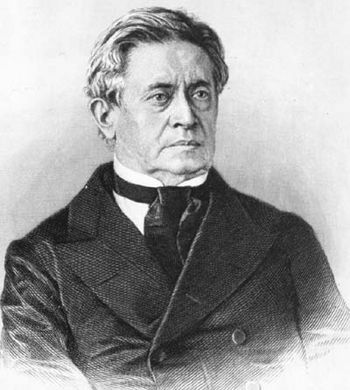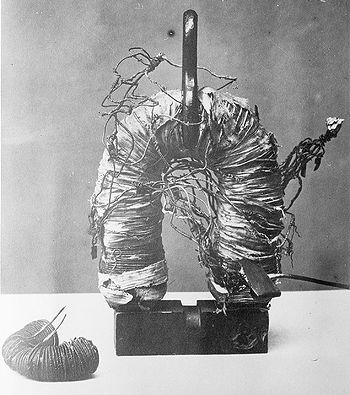Joseph Henry: Difference between revisions
No edit summary |
No edit summary |
||
| (7 intermediate revisions by the same user not shown) | |||
| Line 1: | Line 1: | ||
Compiled by Victor Barr 12/1/2015 | |||
[[File:JHenry.jpeg | 350px |thumb | right | Joseph Henry in his later ages ]] | |||
==Early Life== | |||
Joseph Henry was born on December 17th, 1797 in Albany, New York. Both his mother, Ann Alexander Henry, and father, Joseph Henry Sr., were Scottish newcomers that taught their son the importance of diligence and hard work. Though his father's untimely death caused money issues, his grandmother in Galway, New York took young Joseph in. Joseph, now 13 years old, took apprenticeships with both a watchmaker and a silversmith. However, at the age of 16, Joseph found his passion for science. Specifically, after reading Gorge Gregory's ''Lectures on Experimental Philosophy, Astronomy, and Chemistry'', Joseph wanted to "invest into a new world of thought and enjoyment". [https://www.princeton.edu/ssp/joseph-henry-project/albany-electromagnet/AlbanyMagnetPaper.pdf 1] | |||
Joseph Henry spent his next three years attending Albany Academy. Doing well above average, he found work afterward as a surveyor and tutor. However, after four years, he returned to Albany Academy to teach in mathematics and natural philosophy. | |||
Joseph Henry married his cousin, Harriet Alexander in 1830 and later had 4 children. | |||
[[File:AlbanyMagnet.jpeg | 350px | thumb | right | The Albany Magnet]] | |||
== | ==Scientific Achievements== | ||
Joseph Henry is one of the American figurehead's of physics and was a well known scientist during his time. In 1831, he began working on electromagnetism. Detailed experiments trail on about his findings, and his bigger accomplishments in electromagnetism lead to the creation of the telegraph and the electric motor. Through many layers of insulated wires, he created an electromagnet he called the 'Albany Magnet'. After this creation, he gained international respect from those such as Faraday who was also working on similar areas at the same time. | |||
=== | ===Albany Magnet=== | ||
== | Henry's experimental magnet, it was the most powerful magnet at that time. Around 1825, William Sturgeon, worked on advancing past theories in electromagnetism by messing with how current affects wire wrapped around metal. Henry wanted to improve the loose electromagnets that Sturgeon had been working on. Instead of using bare wire to create his electromagnet, he used silk to wrap the wire before winding the wire around a base. He found that the insulated wire actually increases the lifting power of his magnet. Specifically by tightening the wire around the magnetic, Henry increased the number of loops he made with the wire which directly affect the magnetic field strength of the magnet. This is shown below where B is the magnetic field strength, N is the number of turns in the coil, I is the current through the wire, and L is the length of the magnetic circuit. | ||
<math>{B{{=}}{NI\over L}}</math> | |||
===Smithsonian Institution=== | |||
In 1846, the Smithsonian was still a new institution that just formed roots. Joseph Henry was invited to be a part of this now prestigious organization and resided as the Secretary of the institution. This is where he worked with many other scientists and innovators on mainly practical advice. He also worked to keep the Smithsonian away from being just an administrative organization but also one that directly supported the science in America. From 1867 to his death, he lead the Smithsonian and as the President of the National Academy of Sciences. During this time, he made sure that American would support science in both the educational level but also the professional research level. | |||
==Past his life== | |||
Joseph Henry passed away in Washington D.C. on May 13th, 1878. | |||
He has left his mark in many ways from electricity to encouraging others to search into the field of science and of course physics specifically. Because of his discoveries of electromagnetic induction, The International System of Units named the unit of electrical inductance the henry (H). Also interestingly, the term yrneh, noted from henry spelled backwards, is used to measure reluctance. However, the yrneh is not a universally accepted term. | |||
== See also == | == See also == | ||
===External Links=== | |||
[https://www.princeton.edu/ssp/joseph-henry-project/albany-electromagnet/AlbanyMagnetPaper.pdf Joseph Henry's Experimental Electromagnet] | |||
[http://www.pnas.org/content/58/1/1.full.pdf Joseph Henry Biography] | |||
==References== | ==References== | ||
[http://siarchives.si.edu/history/joseph-henry History of Joseph Henry - Smithsonian Archives] | |||
[http://www.edisontechcenter.org/JosephHenry.html Joseph Henry Profile] | |||
[[Category: | [[Category:Notable Scientist]] | ||
Latest revision as of 22:03, 1 December 2015
Compiled by Victor Barr 12/1/2015

Early Life
Joseph Henry was born on December 17th, 1797 in Albany, New York. Both his mother, Ann Alexander Henry, and father, Joseph Henry Sr., were Scottish newcomers that taught their son the importance of diligence and hard work. Though his father's untimely death caused money issues, his grandmother in Galway, New York took young Joseph in. Joseph, now 13 years old, took apprenticeships with both a watchmaker and a silversmith. However, at the age of 16, Joseph found his passion for science. Specifically, after reading Gorge Gregory's Lectures on Experimental Philosophy, Astronomy, and Chemistry, Joseph wanted to "invest into a new world of thought and enjoyment". 1
Joseph Henry spent his next three years attending Albany Academy. Doing well above average, he found work afterward as a surveyor and tutor. However, after four years, he returned to Albany Academy to teach in mathematics and natural philosophy.
Joseph Henry married his cousin, Harriet Alexander in 1830 and later had 4 children.

Scientific Achievements
Joseph Henry is one of the American figurehead's of physics and was a well known scientist during his time. In 1831, he began working on electromagnetism. Detailed experiments trail on about his findings, and his bigger accomplishments in electromagnetism lead to the creation of the telegraph and the electric motor. Through many layers of insulated wires, he created an electromagnet he called the 'Albany Magnet'. After this creation, he gained international respect from those such as Faraday who was also working on similar areas at the same time.
Albany Magnet
Henry's experimental magnet, it was the most powerful magnet at that time. Around 1825, William Sturgeon, worked on advancing past theories in electromagnetism by messing with how current affects wire wrapped around metal. Henry wanted to improve the loose electromagnets that Sturgeon had been working on. Instead of using bare wire to create his electromagnet, he used silk to wrap the wire before winding the wire around a base. He found that the insulated wire actually increases the lifting power of his magnet. Specifically by tightening the wire around the magnetic, Henry increased the number of loops he made with the wire which directly affect the magnetic field strength of the magnet. This is shown below where B is the magnetic field strength, N is the number of turns in the coil, I is the current through the wire, and L is the length of the magnetic circuit.
[math]\displaystyle{ {B{{=}}{NI\over L}} }[/math]
Smithsonian Institution
In 1846, the Smithsonian was still a new institution that just formed roots. Joseph Henry was invited to be a part of this now prestigious organization and resided as the Secretary of the institution. This is where he worked with many other scientists and innovators on mainly practical advice. He also worked to keep the Smithsonian away from being just an administrative organization but also one that directly supported the science in America. From 1867 to his death, he lead the Smithsonian and as the President of the National Academy of Sciences. During this time, he made sure that American would support science in both the educational level but also the professional research level.
Past his life
Joseph Henry passed away in Washington D.C. on May 13th, 1878.
He has left his mark in many ways from electricity to encouraging others to search into the field of science and of course physics specifically. Because of his discoveries of electromagnetic induction, The International System of Units named the unit of electrical inductance the henry (H). Also interestingly, the term yrneh, noted from henry spelled backwards, is used to measure reluctance. However, the yrneh is not a universally accepted term.
See also
External Links
Joseph Henry's Experimental Electromagnet
References
History of Joseph Henry - Smithsonian Archives Joseph Henry Profile